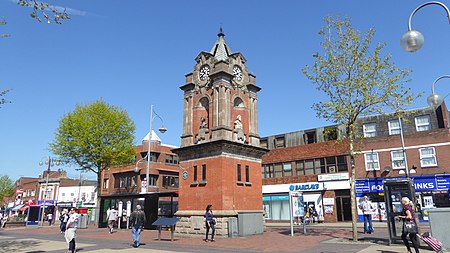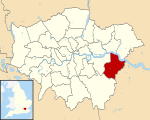Broadway Shopping Centre, (branded as The Mall Bexleyheath from c. 2004 until reverting to its original name in 2009), is the principal covered shopping centre in the town centre of Bexleyheath and is the largest single covered shopping facility in the London Borough of Bexley.
Whilst some parts of the centre opened in 1981, Woolworths being the first on 23 November, the centre was opened in its current form by Prince Philip, Duke of Edinburgh on the thirteenth of March 1984 and underwent an extensive refurbishment in 2007. It had been due to form part of a wider regeneration of the surrounding area of Bexleyheath over the coming years, which would have seen additional retail amenity, Bexley Council offices, a library and residential development adjacent to the existing building. However, in 2010, following the sale of the centre, its new owners confirmed the major expansion plan would not be going ahead, though a small extension to the existing site remains a possibility.There are 59 retail shop units considered to be within the Mall building (including several premises where public access is from the Broadway itself) and additional smaller retailers in 'RMUs' (small, freestanding kiosk-like units).In the early years of the centre's existence, the site was known as the Broadway Shopping Centre; its owners included Norwich Union. In the early 21st century the building was acquired by the Mall Fund, becoming one of their network of centres under the generic "The Mall" branding. The Mall Fund subsequently purchased the neighbouring Broadway Square, and ran it alongside The Mall. In 2009, The Mall Fund's parent company Capital & Regional agreed a deal to sell the centre to Jones Lang LaSalle. As a result of its departure from the network, use of the Mall corporate material declined, though some elements (such as signage and branding) remained under The Mall identity, being replaced over a period of time. Other centres which have been sold off by The Mall Fund (such as The Ashley Centre) have reverted to their former names following their sale. Some marketing materials for the centre, as of Spring 2010, began to appear bearing the names 'Broadway' or 'Broadway Shopping Centre' in plain text. In September 2010, new signage bearing the name "Broadway Shopping Centre Bexleyheath", with the centre's new red-and-white logo, began replacing the Mall-branded elements. The full rebranding of the centre was timed to coincide with the opening of major new H&M and New Look stores on the former Woolworths site.
Following the sale of the centre, it was removed from The Mall's corporate website; initially, it did not have a dedicated website of its own as a replacement. However, JLL subsequently established one at broadwayshoppingcentre.com - with signs promoting this URL appearing in the centre from September 2010.
In April 2016, Jones Lang LaSalle concluded the sale of the Bexleyheath complex to NewRiver Retail.








